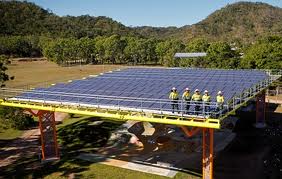A trial on Magnetic Island, in north Queensland, has found lots of solar PV can be incorporated onto a small grid, and can help defer costly network upgrades.
A recently completed program under the Solar Cities program monitored what happened when a small and isolated grid has a lot of solar installed – a phenomenon that is expected to grip all of Australia in coming years.
On Magnetic Island, just over 1.1MW of rooftop solar was installed, mostly on individual rooftops but with one 100kW installation at the local skate park. Average penetration was 22 per cent, although at time it was up to 32 or 35 per cent.
According to Ergon Energy, the trial has been a success, delivered a lot of information about how it can manage solar PV elsewhere in the grid, and helped to defer an $18 million upgrade by nearly a decade.
Ergon Energy said in its annual report released this week (which also noted how many of its customers in regional Queensland are turning to solar) that the Magnetic Island project had reduced peak demand on the island by 16 per cent, down to 2005 levels.
And it had deferred the need to build a costly third submarine cable to the island by at least eight years. Magnetic Island has a population of around 2,500 people, but experiences a big influx of tourists in holiday season, and a big jump in air-conditioning usage that goes with that.
“The project demonstrated that a comprehensive community engagement program can drive real change to the benefit of customers, electricity utilities and the environment,” Ergon Energy wrote in its report. “Despite ending, trials at the heart of the project around solar and hot water load control will continue as part of other sustainable energy initiatives being undertaken.”
The Australian PV Association, which has also compiled a report on the project, says the experience on Magnetic Island was part of the “remarkable, customer led transformation” of the electricity sector.
“PV is likely a precursor to a potentially wide range of other distributed energy options to come, and poses a range of issues, given its location within the distribution network at customer premises, power electronics interface, and the highly variable and somewhat unpredictable nature of the solar resource.
“PV is already presenting challenges for network service providers, forcing changes to engineering and business practices.”
APVA chaimperson Muriel Watt said the main finding was that solar PV did not cause as many problems as some operators anticipate. There were voltage issues, but these were not necessarily caused by solar PV, but alerted by it. These issues had all been addressed by a change in engineering and business practices.
“I think the local operator has learned a lot about their own grid – not just how to deal with solar PV, but a host of other things that will with a smart grid.
Watt said that projects such as Magnetic island were essential but the lessons had come too late to avoid a lot of un-necessary investment in recent years.
“If we were going to spend $50 billion, we should be doing it to make grid smarter, rather than strengthening a grid and not making it smarter. We won’t need the extra capacity that they will put in. We have spent money in the wrong way and we will end up with stranded assets.”
Watt noted that Ergon Energy has one of the lowest customer densities in the world – just 4 per kilometre. “In most other parts of the world, they just wouldn’t put a grid up,” she said.
That appears to be a lesson that Ergon Energy itself is absorbing. It has suggested that solar and batteries may be a cheaper option for consumers than accessing electricity through the grid by the end of the decade.
Watt noted that one transformer had experienced 75 per cent penetration from rooftop solar during the trial. “That’s pretty high, but they coped.”
Watt said it was clear – and a CSIRO study had also pointed to this – that solar PV could rise to 30-35 per cent penetration with only a minimum amount of adjustments and investments being made. A lot of these things are low cost and maybe need to be done anyway. It’s only when customers want to do their own thing (and leave the grid) that network operators get (antagonistic).










